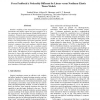Free Online Productivity Tools
i2Speak
i2Symbol
i2OCR
iTex2Img
iWeb2Print
iWeb2Shot
i2Type
iPdf2Split
iPdf2Merge
i2Bopomofo
i2Arabic
i2Style
i2Image
i2PDF
iLatex2Rtf
Sci2ools
133
click to vote
HAPTICS
2007
IEEE
2007
IEEE
Force Feedback is Noticeably Different for Linear versus Nonlinear Elastic Tissue Models
Realistic modeling of the interaction between surgical instruments and human organs has been recognized as a key requirement in the development of high-fidelity surgical simulators. Primarily due to computational considerations, most of the past simulation research within the haptics community has assumed linear elastic behavior for modeling tissues, even though human soft tissues generally possess nonlinear viscoelastic properties. Hence, this paper quantitatively compares linear and nonlinear elasticity-based models. It is demonstrated that, for a nonlinear model, the well-known Poynting effect developed during shearing of the tissue results in normal forces not seen in a linear elastic model. The difference in force magnitude and force direction for linear and nonlinear models are larger than the just noticeable difference for contact force and forcedirection discrimination thresholds published in the psychophysics literature, respectively. This work applies a proposed framework f...
| Added | 02 Jun 2010 |
| Updated | 02 Jun 2010 |
| Type | Conference |
| Year | 2007 |
| Where | HAPTICS |
| Authors | Sarthak Misra, Allison M. Okamura, K. T. Ramesh |
Comments (0)

